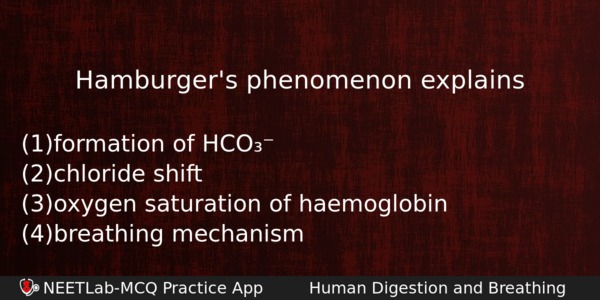| ⇦ | 
| ⇨ |
Hamburger’s phenomenon explains
Options
(a) formation of HCO₃⁻
(b) chloride shift
(c) oxygen saturation of haemoglobin
(d) breathing mechanism
Correct Answer:
chloride shift
Explanation:
Removal of CO₂from blood involves both influx of Cl ̄ions into RBCsand efflux of HCO₃ ̄ions from RBCs. Exit of bicarbonate ions, considerably change ionic balance between the plasma and the erythrocytes (RBCs). To restore this ionic balance, the chloride ions diffuse from the plasma into erythrocytes. This movement of chloride ions is called chloride shift (Hamburger’s phenomenon).
Related Questions: - Which of the following vein has least amount of urea
- In meiosis crossing over is initiated at
- Megasporangium is equivalent to:
- In a standard ECG which one of the following alphabets is the correct representation
- Which one of the following statement is correct about evolution
Topics: Human Digestion and Breathing
(167)
Subject: Biology
(4253)
Important MCQs Based on Medical Entrance Examinations To Improve Your NEET Score
- Which of the following vein has least amount of urea
- In meiosis crossing over is initiated at
- Megasporangium is equivalent to:
- In a standard ECG which one of the following alphabets is the correct representation
- Which one of the following statement is correct about evolution
Topics: Human Digestion and Breathing (167)
Subject: Biology (4253)
Important MCQs Based on Medical Entrance Examinations To Improve Your NEET Score
18000+ students are using NEETLab to improve their score. What about you?
Solve Previous Year MCQs, Mock Tests, Topicwise Practice Tests, Identify Weak Topics, Formula Flash cards and much more is available in NEETLab Android App to improve your NEET score.
Share this page with your friends

Leave a Reply